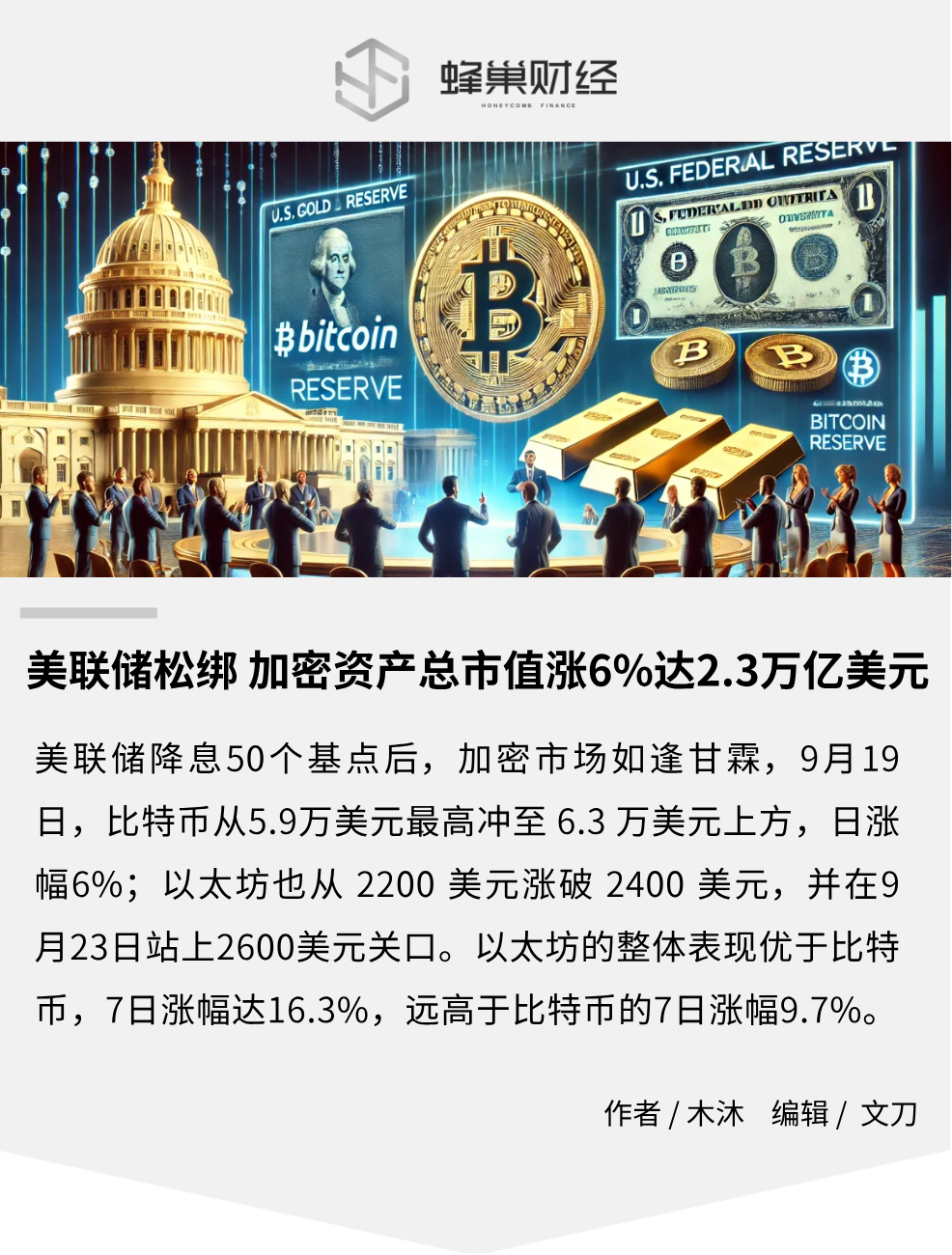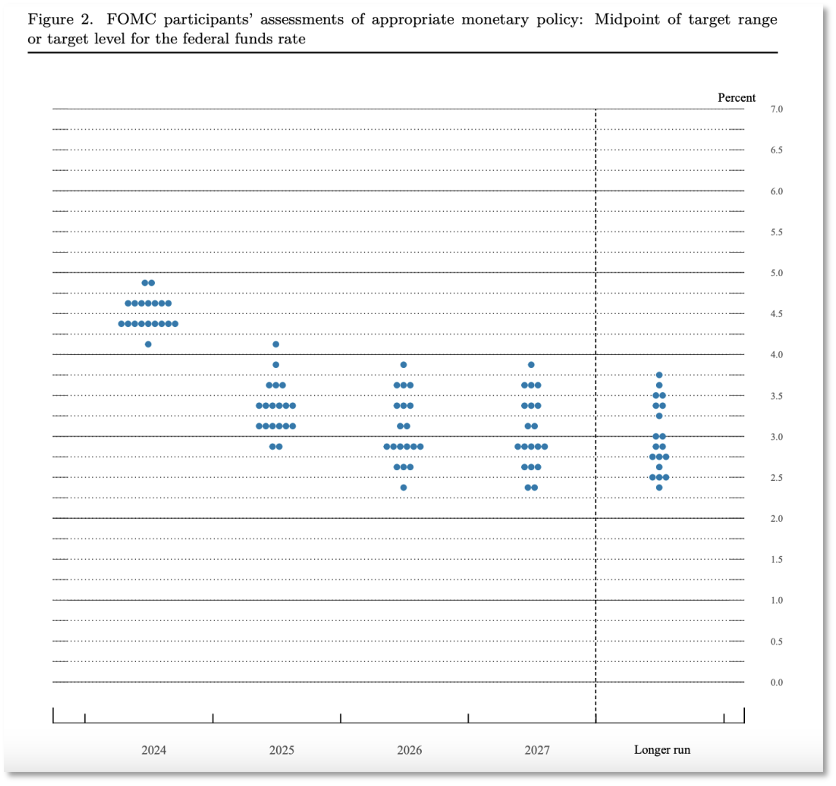
The Federal Reserve has finally completed its first interest rate cut since March 2020, shifting its monetary policy from a tightening cycle to an easing cycle.
On September 18th local time, the Federal Reserve announced a 50 basis point cut in the target range for the federal funds rate, lowering it to a level between 4.75% and 5.00%. Federal Reserve Chairman Powell stated that the 50 basis point rate cut was a "strong action."
The cryptocurrency market seemed to welcome the dawn. On September 19th, the price of Bitcoin fluctuated significantly, rising from a high of $59,000 to above $63,000, with a daily increase of 6%. On September 23rd, it further broke through to near $64,600. Ethereum also rose from $2,200 to above $2,400, and on September 23rd, it surpassed the $2,600 mark. The overall market value of the cryptocurrency market also rose by 6% five days after the rate cut, reaching $2.3 trillion.
After the first interest rate cut, the market generally expects further rate cuts in the fourth quarter. Apart from emergency rate cuts during the crisis, a 50 basis point rate cut by the Federal Reserve is not common. The last significant rate cut occurred in 2020, when faced with the impact of the COVID-19 pandemic, the Federal Reserve implemented an aggressive rate cut policy, lowering rates to near zero. At that time, the price of Bitcoin did not immediately soar, but it broke through the $30,000 mark at the end of the year.
Historically, rate cuts typically drive up the price of Bitcoin. After this rate cut, will the cryptocurrency market once again repeat history?
The "Boot" of Rate Cuts Lands

Since the second half of this year, Bitcoin has been on a roller coaster ride in the cryptocurrency market, and after entering August, it has continued to fluctuate at a low level, with the federal funds rate becoming the focus of the cryptocurrency market.
A rate cut refers to the Federal Reserve lowering the federal funds rate, which is the benchmark interest rate for interbank borrowing in the United States. A rate cut means that borrowing costs are reduced, making it easier for businesses and individuals to obtain loans, thereby stimulating economic activity, increasing employment, and controlling inflation. Rate cuts reduce the cost of funds, stimulate economic activity and investment, and make investors more inclined to high-risk, high-return assets, including not only stocks but also other cryptocurrencies such as Bitcoin.
From 2008 to 2022, the federal funds rate in the United States has been maintained in the extremely low range of 0-0.25%, with a moderate increase starting in 2016, but never exceeding 2.25%.
During the prolonged inflation resistance in the United States, the Federal Reserve continuously raised the federal funds rate, with a total of 7 rate hikes from March to the end of the year in 2022, with a cumulative increase of 425 basis points. By December 2022, the Federal Reserve raised the target range for the federal funds rate to 4.25%-4.50%, the highest level since the 2008 global financial crisis.
As of September 8, 2024, the target range for the federal funds rate set by the Federal Reserve is 5.25%-5.50%. From the chart, it can be seen that the federal funds rate in the United States is currently at its highest level in over a decade.
The pace of rate hikes finally stopped in September. On September 18th local time, the Federal Reserve announced a 50 basis point cut in the target range for the federal funds rate, lowering it to a level between 4.75% and 5.00%. Federal Reserve Chairman Powell stated that the 50 basis point rate cut was a "strong action," emphasizing that a significant rate cut does not indicate that a recession is imminent in the United States. Rather, the rate cut is more of a preventive action aimed at maintaining the sound state of the economy and labor market.
 Federal Reserve dot plot
Federal Reserve dot plot
The dot plot shows that the median expectation of the 19 policymakers for the year-end Federal Reserve rate in 2024 falls between 4.25% and 4.5%. This means that overall, they believe that there will be an additional cumulative rate cut of 50 basis points by the end of the year.
ETH Rebound Outperforms BTC

After the rate cut by the Federal Reserve, the three major U.S. stock indexes collectively fell on September 18th, and the rate cut did not meet expectations for boosting U.S. stocks. In contrast, the performance in the cryptocurrency sector was more optimistic, especially for the two largest assets by market value, Bitcoin and Ethereum, both of which entered the sequence of assets in U.S. stock ETFs last year and this year, respectively.
After the rate cut news on September 19th, Bitcoin (BTC) rose, reaching above $63,000 from a high of $59,000, with a 6% increase within the day. Ethereum (ETH) also rose from $2,200 to above $2,400, and on September 22nd, it broke through to above $2,600.
However, Ethereum's overall performance was better than Bitcoin's, with a 7-day increase of 16.3%, far exceeding Bitcoin's 7-day increase of 9.7%.
In addition, SOL also achieved an increase of over 20% on the day of the rate cut news, while the meme coin DOGE increased by 3%, and the Bitcoin ecosystem's token ORDI and SATS achieved nearly 10% increases.
As cryptocurrency prices collectively rose, Bitcoin spot ETFs also ended 8 consecutive days of net outflows. Since September 12th, Bitcoin spot ETFs have seen net inflows for 4 consecutive days, indicating that confidence from off-exchange funds is gradually recovering.
Many market professionals are optimistic about the rate cut by the Federal Reserve, believing that it will boost Bitcoin and the cryptocurrency market. Anthony Scaramucci, founder of the hedge fund Sky Bridge, believes that this is good for asset prices in the United States and globally. With a series of rate cuts by the Federal Reserve and clearer regulation of cryptocurrency assets in the United States, Bitcoin is expected to reach a new historical high of $100,000 by the end of the year.
From a theoretical and historical perspective, rate cuts do tend to drive up the price of Bitcoin.
In 2019, the Federal Reserve cut rates in July, September, and October, lowering the target range for the federal funds rate to 1.5%-1.75%. Before the rate cuts, the price of Bitcoin had already risen from about $4,000 at the beginning of the year to $8,000. After the rate cut news, the price of Bitcoin reached a high of $10,000 in July, but then fell back.
In 2020, faced with the impact of the COVID-19 pandemic, the Federal Reserve implemented a more aggressive rate cut policy, lowering rates to near zero. Despite this, the price of Bitcoin did not immediately soar, but broke through the $30,000 mark at the end of the year.
However, despite the "watering down" effect of rate cuts, it has also cast a shadow over economic recession. Some Federal Reserve officials are concerned that too rapid rate cuts may lead to a rebound in demand, keeping inflation high. Republican presidential candidate Trump believes that this shows that the U.S. economy is in bad shape. "Assuming they're not playing politics, such a large cut indicates that the economic situation is very bad."
Peter Cardillo, Chief Market Economist at Spartan Capital Securities, believes that the Federal Reserve's move is clearly dovish, mainly due to concerns about an overly weak labor market. Although the stock market reacted positively after the rate cut news, market sentiment may change in the coming days, and investors may begin to worry about the economic outlook.
Compared to traditional financial markets such as stocks, Crypto Rover, founder of CryptoSea, is more optimistic about the future development of Bitcoin. He stated, "The last time this happened, the bull market for Bitcoin began." Lark Davis, founder of Wealth Mastery, also has a positive outlook on the long-term trend of Bitcoin, emphasizing, "If history repeats itself, the next 6-12 months will be crazy."
In any case, the rate cut cycle has begun. Among the 19 officials within the Federal Reserve, 7 officials believe that there should be an additional 25 basis point rate cut in 2024, 9 officials believe that there should be an additional 50 basis point rate cut in 2024, and 7 officials believe that there should be an additional 75 basis point rate cut in 2024, with only 2 officials believing that there should be no further rate cuts in the remaining meetings of 2024.
Employment market data will shape the pace and endpoint of future rate cuts. With the passage of time and the sustainability of rate cuts, market liquidity will become more active, and some funds are likely to flow out of bonds and banks and into stocks, cryptocurrencies, and other markets.
(Disclaimer: Readers are strictly required to comply with local laws and regulations. This article does not represent any investment advice.)

免责声明:本文章仅代表作者个人观点,不代表本平台的立场和观点。本文章仅供信息分享,不构成对任何人的任何投资建议。用户与作者之间的任何争议,与本平台无关。如网页中刊载的文章或图片涉及侵权,请提供相关的权利证明和身份证明发送邮件到support@aicoin.com,本平台相关工作人员将会进行核查。



